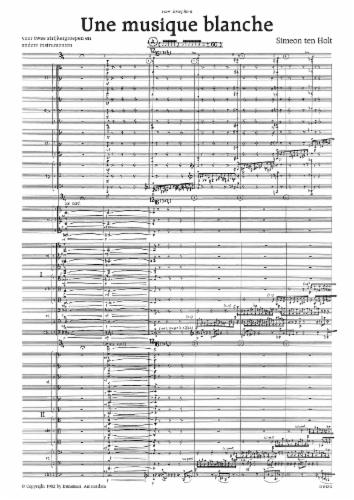Une musique blanche

Program note :
The orchestra consists of several groups: A, B, C, D, and the string groups I and II. If possible these groups are located next to or opposite each other with a clear separating space between them. Each group has its own musical structure as to beginning and ending and its own process timewise.
Time structure is characterised by a gradual shift (flowing) of the sound picture. General speaking it can be said that when the building-up stage of one group has reached its culmination, the space is cleared for the development of another (timbre)group to take place. This one in its turn will make space for a third generation, etc.
Although a vertical accumulation of tones takes place at certain stages (clusters), the composition is played in unison. The tonal body of one separate tone differs from the tonal body of two, three, four, etc. tones or pitches. This holds good for the moments of silence (rests) as well.
The mask of time that has been designed is consistently linked to the rules of the game. It is meant to articulate the basic current of ongoing sixteenth tones in time and space. The tone substance (of that basic current) consists of a chain of interlinked series of intervals.
Any memory of melody and harmony is set aside. There is no essential preference as to a jump up or a jump down and we see that, as far as we can speak of instrumental unification, an interval up (e.g. 7) is mirrored in an interval (5) down. The minuses and plusses taken together meet on the neuter zero line of the unison situation. ‘On revient toujours à la blancheur de l’unisson’.
Although all members of the ensemble, within the framework of their group, contribute to the creation of the basic current of sounds, and all members are equally important, the separate voices can be characterised all the same. The speed will be from flowing to fast (or faster) and, when fixed, being maintained. With thanks to Stan Tempelaars.
SIMEON TEN HOLT

